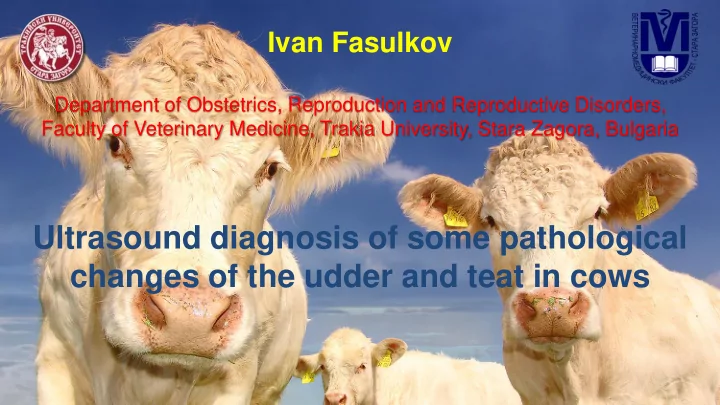

Ivan Fasulkov Department of Obstetrics, Reproduction and Reproductive Disorders, Faculty of Veterinary Medicine, Trakia University, Stara Zagora, Bulgaria Ultrasound diagnosis of some pathological changes of the udder and teat in cows
Introduction • Udder health plays an important role in modern dairy farming and is the basis for an economical and hygienic milk production process. • In the dairy industry, prophylactic procedures are just as important as therapeutic ones. Milk flow disorders are a central problem in the practice. They are preconditions of different types of mastitis, which consequently leads to a loss in milk production, detrimental changes to the milk components and raw milk quality, increased costs for the treatment of the animal, early culling of dairy cows, and, hence, a negative economic impact (Franz et al., 2009).
Introduction • A rapid and accurate diagnosis and prognosis are mandatory in patients with udder diseases, and requires use of modern examination techniques and therapeutic procedures. • Ultrasonography is a non-invasive exploratory method for diagnosis of different diseases and obtaining data during physiological conditions (i.e., lactation and dry period). • Numerous authors report ultrasonographic findings of a normal mammary gland of ruminants, primarily in cattle. • There are only few reports for application of this method in diagnostics of pathological changes of the udder and the teat in cows.
Purpose • The present study aimed to evaluate the possibility of the ultrasonography for diagnosis of some pathological changes of the udder and teat in dairy cows.
Material and methods • The investigation was carried out with sixty-four Holstein-Friesian cows (aged 4-8 years, weighing 530-620 kg, raised at dairy farm in Plovdiv district) separated in two groups. • Group I (n=58) included animals with pathological changes of the mammary gland while group II (control, n=6) was with clinically healthy cows.
Material and methods • B-mode ultrasonography was done by ultrasound device SonoScape S2Vet (SonoScape, China) with multifrequency linear and convex transducers and direct contact technique. • A contact gel (Eco-ultra gel, Milano, Italy) was applied for better visualization.
Results • In healthy cows from group II, ultrasound examination showed typical structure of teat and udder parenchyma. • The teat canal was seen as a hyperechoic structure, the Furstenberg’s rosette was hypoechoic and the lumen of the teat cistern had anechoic image in milk collection. • The mammary gland parenchyma was visualized as homogenous and hypoechoic structure with anechoic zones identified as blood vessels or lactiferous ducts.
Results • In group I, 48%, 19%, 17.2%, 15.5% had acute clinical mastitis, abscesses, chronic indurative mastitis and teat stenosis, respectively.
Results • The results indicate that cows with clinical mastitis have typical ultrsonographic characteristics in udder and teat such as echogenic milk floccules into the teat cistern, thickened of the teat wall, structures with non-homogeneous echogenicity into the udder parenchyma and most commonly small hyperechogenic zones.
Results • In cows with chronic indurative mastitis, the ultrasonographic findings included hypoechogenic image of the teat cistern due to development of connective tissue, lack of visualization of a teat canal, glandular cistern and milk tubular system into udder parenchyma.
Results • Abscesses were visualized as multiple oval formations or large solitary structure with a typical capsule and/or thickness wall, located into mammary gland parenchyma.
Results • Teat stenosis were presented distally to the teat cistern including teat orifice, teat canal and Furstenberg’s rosette, also in the middle and proximal part of the teat cistern. They were observed as hypoechogenic structures.
Conclusion • The obtained results showed that ultrasonography is an accurate method for diagnosis of the udder and teat pathology in dairy cows. • It can be used in the practice as supplementary method for in vivo evaluation of the udder changes in physiological and pathological processes.
Recommend
More recommend